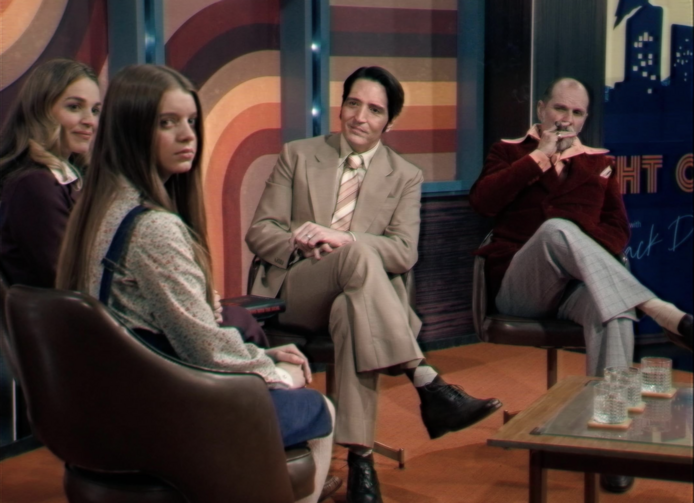The devil appears in many ways, but a guest on late-night TV?
On Jan. 17, 1974, Johnny Carson hosted William Peter Blatty, author of The Exorcist, on The Tonight Show. Blatty’s book, perhaps the finest piece of Catholic horror ever written, had drawn mass interest in the 1970s. The episode of The Tonight Show included the comedian Richard Pryor, but Blatty was the final guest of the night—the main event.
At that time the film version of Blatty’s book was widely touted as the most disturbing movie ever created and one that should not be seen alone. It was less a warning for the frail of heart than an encouragement to watch the film as a group experience. “The film is an assault upon the nervous system, and the concentration of other bodies around you, other brains around you, is part of the effect, the impact of the film,” Blatty told Carson.
The new film “Late Night with the Devil,” directed by brothers Cameron and Colin Cairnes, imagines if one of Carson’s talk show competitors attempted to communicate with demons on live TV: a concentration of bodies and brains witnessing something deeply disturbing in front of their very eyes.
Jack Delroy (played by David Dastmalchian) is a fictional late-night personality whose program “Night Owls” has taken a tumble in the ratings. It cannot compete with more established names like Johnny Carson, just one of the cultural touchstones from the 1970s that root the viewer in the period. News clips of the Vietnam War, snippets of President Richard Nixon’s resignation speech and footage of the “Son of Sam” killer David Berkowitz in handcuffs place the viewer in a specific moment of American history.
Shot by the Cairnes brothers with the warm lighting and signature crackling of 1970s-era television cameras, the film’s tone is playful at first. It shows Delroy’s guests as innocent zookeepers and B-list actors performing mildly funny skits on the show. But as viewership starts dropping, we get a brief glimpse into Delroy’s involvement with The Grove, a secret society in northern California that is alleged to be a cult.
In an attempt to rekindle his comeback after his wife’s death from lung cancer, Delroy plans an ambitious panel of personalities for Halloween night in 1977. His guests are Christou, a self-proclaimed medium; Carmichael Haig, a former magician who plays the skeptic of the bunch; and Dr. June Ross Mitchell (Laura Gordon) a parapsychologist. Ross is the legal guardian of Lilly (Ingrid Torelli,) a young girl who survived a mass suicide by a cult that worshipped “Abraxas,” a spirit considered to be a demon by the Catholic Church.
The events from that Halloween night in 1977 are presented in the vein of “found footage” horror films, a genre popular in the early 2000s that can be hit or miss: think “The Blair Witch Project” (hit) and the “Paranormal Activity” franchise (mostly miss). “Late Night with the Devil” is definitely a hit.
Modern horror movies rooted in Catholic themes are often overly dramatic, jump-scare reliant and shot heavily in the dark. “Late Night” goes against the grain on all fronts: the visuals are bright, its horror unfolds right in front of the audience’s eyes, and it is injected with just the right amount of satirical humor and commentary.
The studio audience is at first intrigued when Christou identifies the presence of a spirit who is the dead son and brother of two audience members. But the mood quickly becomes more fraught. Christou is physically overwhelmed by the presence of another spirit, named “Minnie,” which is later revealed to be a private nickname for Madeleine, Delroy’s deceased wife.
Soon thereafter, Dr. Mitchell, the parapsychologist, demonstrates how Abraxas is supposedly still attached to Lilly, possessing her and making her chair levitate. Carmichael Haig, the former magician, performs a group hypnosis experiment to debunk Dr. Mitchell’s demonstration that makes the audience and Delroy’s “Night Owl” sidekick Gus (think Ed McMahon or Andy Richter) believe that his body is crawling with worms. While Carmichael and Dr. Mitchell go back and forth about whether Lilly’s demonstration is real or phony, the show devolves into chaos when Dr. Mitchell is unable to control Abraxas’ influence on Lilly.
The surreal events of the film provide the viewer with more questions than answers: How much of what I just watched “actually happened” in the world of the film? Did Jack ever explicitly make a sacrifice at The Grove to trade his wife’s health for his fame? Was Madeleine’s spirit really present during the taping or was it a manifestation of Jack’s guilt? The television cameras never lie, Carmichael points out to Jack, but in this film, perhaps they do.
The chase for fame is a vice that consumes many people. While Jack is in a dreamlike state, we see an apparition of the deceased Madeleine in her hospital bed asking him, “They told you that you could have it all, didn’t they?” preceded by the image of a young Jack signing a contract with “UBC,” a stand-in for any corporate three letter media organization.
Jack’s Halloween episode with Dr. Carter, Lilly, and Carmichael ended up being “the most watched event since the moon landing” according to his greasy producer Leo; it will undoubtedly never be forgotten in this alternate version of America.
But that is the powerful conundrum of “Late Night with the Devil.” Its driving force is in the tension between just how far Delroy will go to achieve television immortality and his hesitation to put his spouse, Dr. Carter, and Lilly in danger to do so. “Late Night with the Devil” succeeds in giving much-needed depth to a genre that often lacks it.
Jack Delroy begins each episode of “Night Owls” by thanking the audience watching on TV for “allowing me into your homes.” In a sense, Jack has possessed the live audience and at-home audience’s attention; he is possessed by greed and ambition; meanwhile Carmichael is possessed by skepticism and Lilly is possessed by Abraxas.
“Late Night with the Devil” is a film that lives on the knife’s (or dagger’s) edge—a stark reminder that we are all possessed by something.
“Late Night with the Devil” is in theaters now.








